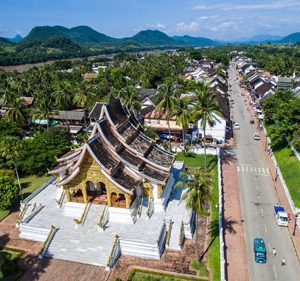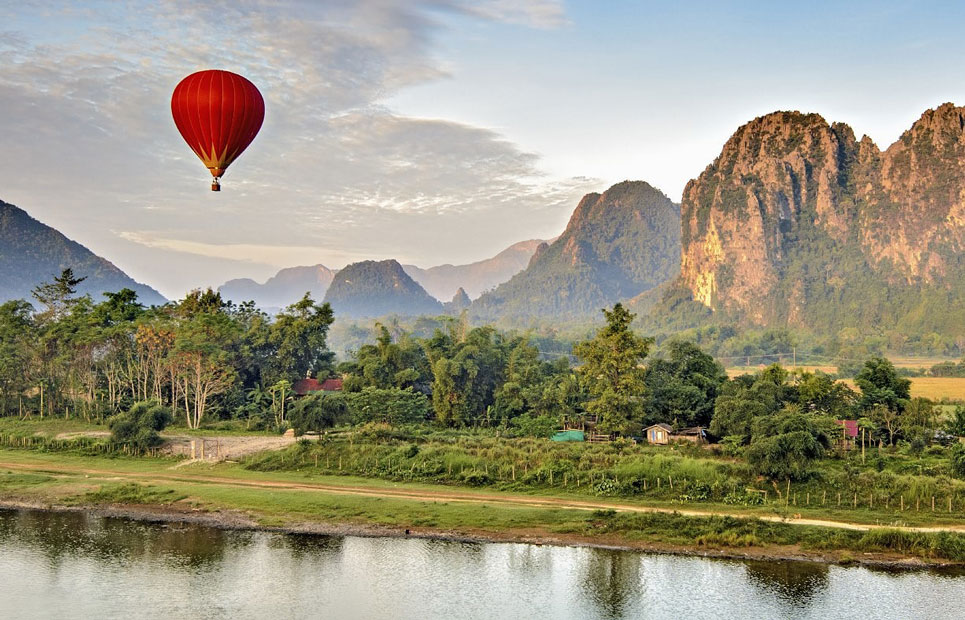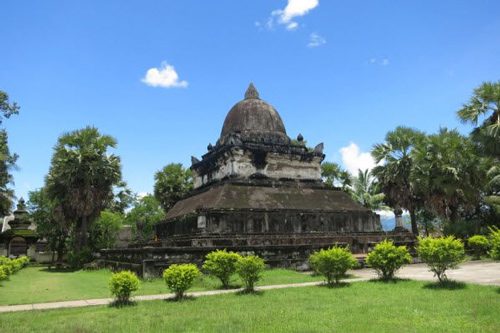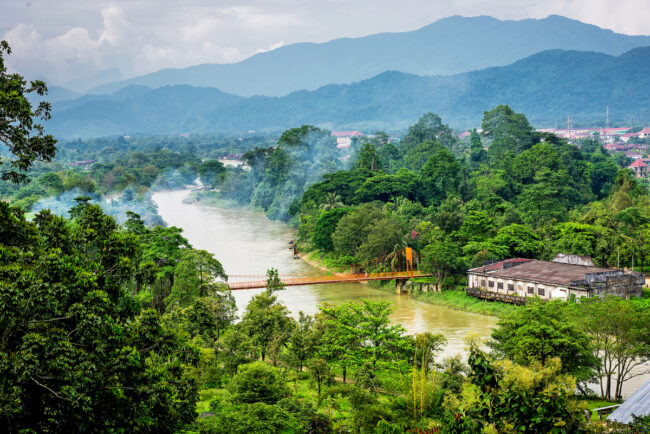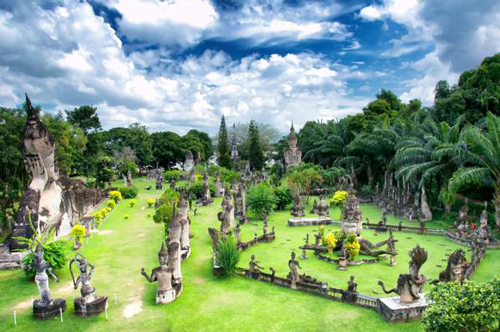Best time to visit Laos
This country is a great destination to travel any time all year-round since the country has no coastline that influences the weather. Laos weather is a tropical climate with two seasons which are dry (May – September) and wet season (October – April). On the bottom line, the best time to travel to Laos is from October to February, which is the cool dry season.
During this time, the average temperature is 21-24 degree Celsius (68-76 degree F) while the humidity is not high and the night remains cool. Another great thing is that during this time frame, the rivers are high enough to make river travel easy and flexible. However, this is the most popular time for travelers to visit the country, so do expect to see more people in this time of the year. Also, in the far south in this time, winter is even warmer and someday could get hot, while the weather gets colder when moving north to the higher altitude.
Read more:
8 days in Northern Laos
Luang Prabang
A trip to Laos would not be complete without spending two days or more in Luang Prabang. Luang Prabang is the former capital city of Laos and it was recognized as a UNESCO World Heritage City in 1995. Considered as the heart of Lao history and culture, this city will amaze tourists with sophisticated French architecture, mesmerizing religious spots, and several places of entertainment.
Wat Xieng Thong
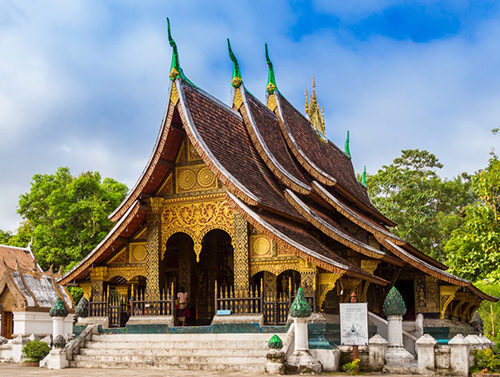
Wat Xieng Thong, Laos
The outstanding Wat Xieng Thong is a highlight of the city. This masterpiece represents the characteristics of typical Luang Prabang’s style with sweeping two-tiered roofs and ornate mosaics. This monastery was built in 1560 by King Setthathirath near the intersection of Mekong and Nam Khan rivers.
Royal Palace Museum
Only 1 kilometer from Wat Xieng Thong is the Royal Palace Museum which was originally inhabited by King Sisavang Vong and his family. The exhibits here include royal religious objects, precious paintings, and statues which can be dated back to centuries ago. Therefore, do not forget to climb to Mount Phousi at dusk to admire the whole view of Luang Prabang on your 8 days in Laos.
Pak Ou Caves
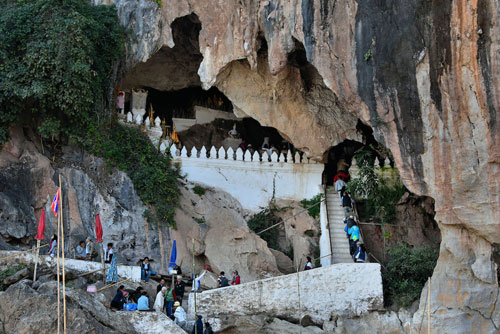
Pak Ou Caves, Laos
25 kilometers to the north of Luang Prabang, Pak Ou Caves are one of the most respected holy sites in Laos, consisting of more than 4000 Buddha icons. These caves have been a place of worship for almost thousands of years. You can visit two caves here, Tham Thing (the lower) and Tham Theung (the upper), housing many Buddhist statues made from wood. The lower cave is well-lit and includes many signs to explain the history of some statues. The upper cave requires a 10-minute trek up some steep steps, but it is worth seeing.
Kuang Si Waterfall
This is also a must-see place outside of the city center. It is an imposing waterfall with a 50-meter drop. This waterfall is absolutely spectacular with turquoise water which is kept in perfectly sculpted limestone tiered pools. You can enjoy sightseeing, swimming, and hiking to the top of the fall. But remember to bring a proper pair of shoes – the road to the top will be muddy! We recommend you coming to this waterfall in the morning when it is not busy yet.
Phonsavan
Phonsavan in the beautiful capital city of Xieng Khouang Province, located in the center of Laos. This city is also known as the Hill of Paradise in Laos with various marvelous sites and destinations, especially the most famous Plain of Jars – one of the top sights in Laos.
Plain of Jars
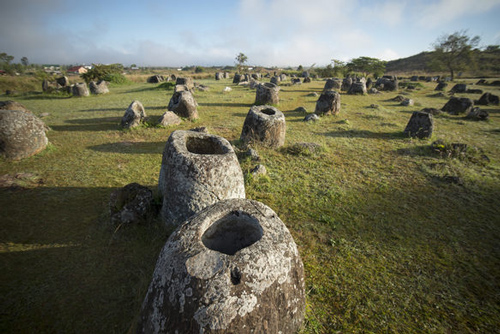
Plain of Jars, Laos
The main reason to come to Phonsavan must be visiting Plain of Jars. Located in Xieng Khouang Province in the northeast of Laos, Plain of Jars is a mysterious ancient scene which is the Asian version of Stonehenge in the United Kingdom. Hundred of clay jars spread over the plain which can be dated to the ancient civilization over 2000 years ago. Scientists still cannot explain how people can place the jars onto the plain, nor the purposes they served. Plain of Jars is now considered an important archeological site in the country and it is a travelers’ favorite place on their tours to Laos.
Baw Nyai
The big hot spring Baw Nyai, 67km from Phonsavan, has been making a lot of tourists immersed into swimming at an indoor pool while admiring outdoor marvelous view out of a jungle. This is a must-visit place on your 8 days in Laos.
Nong Khiaw
Nam Ou River
The Nam Ou spans 450 kilometers, flowing south from mountains near the Lao-China border in Northern Laos to meet the waters of the mainstream Mekong River. Along the way, the river traverses through the provinces of Phongsaly, Oudomxay and Luang Prabang, past mountains, forested valleys and stunning limestone karsts. This is one of the most important rivers in Laos and the only natural channel suitable for large-draft boat transportation.
8 days in Southern Laos
Pakse
Compared to the north and central Laos, the south seems to be quieter and less touristy. However, if you want to discover some off-the-beaten-track attractions in this country, you cannot miss this region. Founded in 1905 by the French, Pakse is considered a starting point on a journey to Southern Laos. This town is located on a peninsula between the Mekong and Xe Don River.
Champasak Palace Hotel
Although most attractive sites in Pakse lie on the outskirts, the town itself is really charming. One of the must-see buildings in Pakse is the imposing Palace of Prince Chao Boun Oum, which is now the Champasak Palace Hotel. Abandoned in 1974, the palace was renovated into a hotel in 1995. Situated in the bridge that spans the Xe Don, Wat Luang is a beautiful temple in town. It is decorated with many sophisticated murals which depict the Buddha’s life and teaching.
Si Phan Don
About 150 kilometers from the south of Pakse, Si Phan Don, which means ‘four thousand islands’, is a famous area with numerous unspoiled island. When you visit this place, you will have a chance to see Irrawaddy dolphin and the magnificent Khone Phapheng falls. The pace of life is really slow in this area and you can watch local people living in stilted houses, raising livestock, and working on rice paddies. Most visited islands in Si Phan Don are Don Khon, Don Det, and Don Khong.
Wat Phou
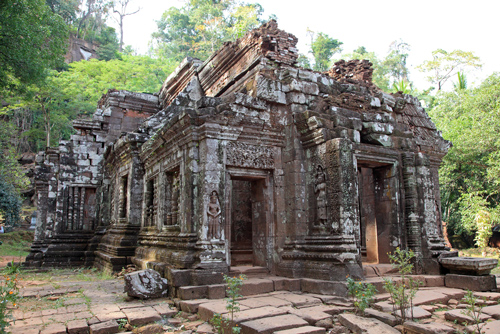
Wat Phou, Pakse
On a cruise to Si Phan Don, you cannot miss Wat Phou, the ancient ruins which can be dated back to the 10thcentury. The east of Pakse is well-known for backpackers and adventurous travelers because of Bolaven Plateau. This place houses many spectacular waterfalls among that the highest one is Tad Fane.
8 days in Central Laos
Vientiane
Vientiane is the smallest capital city in the Southeast Asian region, but there is no lack of fun here. Situated on the bank of the Mekong River, this city possesses a sub-tropical climate and enjoys a slow-paced life. You can visit Vientiane almost any time a year since this city offers a great choice of accommodation, restaurants, sightseeing spots, and entertainment.
That Luang Stupa
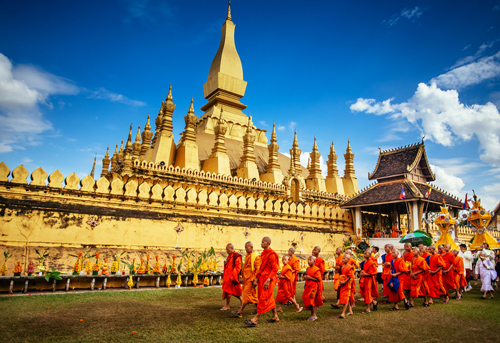
That Luang Festival – Laos
Regarding religious sites, a system of temples and pagodas this city is perfect for you to understand Buddhism and local uniqueness on your 8 days in Laos. That Luang Stupa is a symbol of Laos in terms of both Buddhism and national sovereignty. The legend said that this stupa houses a breastbone of Buddha. That Luang was originally a Hindu temple in the 1st century, however, the current structure was built by King Setthathirat in 1566 when he relocated the capital from Luang Prabang to Vientiane. Wat Ho Phra Keo, Wat Si Muang, Wat Si Saket, and Wat Mai are also worth visiting in Laos during your trip to Southeast Asia.
Vientiane Night Market
Vientiane Night Market organized around the riverside area is a cannot-miss place when going to this city. You can find a lot of souvenirs, shirts, and handicrafts here, but remember to use your bargaining skills because the initial prices are always inflated. The only thing you cannot find here is food; however, do not worry since there are lots of restaurants and shops on the other side of the street.
Buddha Park
25 kilometers southeast of Vientiane, Buddha Park is an extraordinary sculpture park. Constructed by 1958 by Luang Pu (Venerable Grandfather) Bunleua Sulilat who studied both Buddhism and Hinduism, this park contains more than 200 Hindu and Buddhist statues. Three most outstanding statues of the park are the king of Hindu gods riding on a three-headed elephant, a four-armed deity riding a horse, and a 12-faced deity.
Vang Vieng
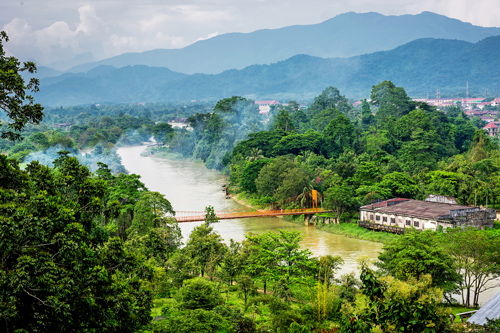
Vang Vieng, Laos
Situated in the middle of Luang Prabang and Vientiane, Vang Vieng is probably a party town in the country with many tourists’ eateries, restaurants, bars, and clubs. Tourists can enjoy exciting and thrilling activities here such as rope swinging, zip lining, swimming, and diving into blue lagoon, and large decks. The spectacular view to Nam Song River along the town is also an unforgettable memory on travelers’ minds.
City highlights:
Some attractions in Vang Vieng are Blue Lagoon, Water Cave (Tham Nam), Elephant Cave (Tham Chang) and Kaeng Nyui Waterfall.
Suggested itineraries for 8 days in Laos
Itinerary 1: Luang Prabang – Vang Vieng – Pakse
Day 1: Arrive in Luang Prabang. Visit Wat Visoun, Wat Xieng Thong, and Mount Phousi.
Day 2: Cruise through Mekong River to visit Pak Ou Caves. In the afternoon, proceed to Kuang Si Waterfall.
Day 3: Visit Royal Palace Museum. In the afternoon, transfer to Vang Vieng.
Day 4: Stop over at Mor Village – a fishing village and enjoy lunch at Nam Ngum Lake area.
Day 5: In the morning, admire Kaeng Nyui Waterfall. In the afternoon, transfer to Pakse.
Day 6: Take a flight to Pakse. Discover magnificent waterfalls, imposing mountains, and colorful ethnic villages in Bolaven Plateau Area.
Day 7: Visit the ruins of Wat Phou Temple Complex, and then continue your trip to Khong Island. Overnight in Khong Island.
Day 8: In the morning, drive back to Pakse for a flight back to Luang Prabang. Depart from Luang Prabang.
Itinerary 2: Vientiane – Phonsavan – Luang Prabang
Day 1: Arrive in Vientiane. Visit the famous That Luang Stupa and Patuxay Monument, Vientiane’s own Arc de Triomphe.
Day 2: In the morning, visit Wat Sisaket and Wat Prakeo. In the afternoon, drive to Buddha Park.
Day 3: City tour around Vientiane and hang around at Vientiane Night Market at night.
Day 4: Transfer to Phonsavan. In the afternoon, visit the legend Plain of Jars.
Day 5: Refresh yourself at an indoor swimming pool in the big hot spring Baw Nyai while admiring the view outside of a jungle. In the afternoon, transfer to Luang Prabang.
Day 6: In the morning, visit Wat Visoun, Wat Xieng Thong, and Mount Phousi. In the afternoon, proceed to Kuang Si Waterfall.
Day 7: In the morning, cruise on Mekong River to visit Pak Ou Caves. In the afternoon, visit Royal Palace Museum.
Day 8: Depart from Luang Prabang.
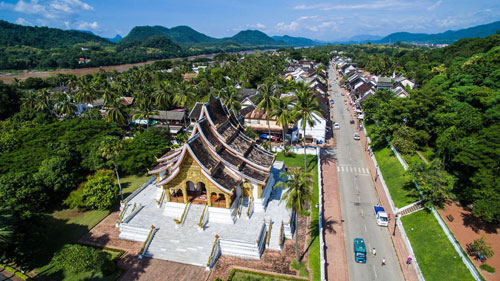
Luang Prabang street, Laos
Itinerary 3: Luang Prabang – Phonsavan – Vientiane – Pakse
Day 1: Arrive in Luang Prabang. Visit Wat Visoun, Wat Xieng Thong, and Mount Phousi.
Day 2: Cruise through Mekong River to visit Pak Ou Caves. In the afternoon, proceed to Kuang Si Waterfall.
Day 3: Visit Royal Palace Museum. In the afternoon, transfer to Phonsavan.
Day 4: In the morning, visit the legend Plain of Jars. In the afternoon, refresh yourself at an indoor swimming pool in the big hot spring Baw Nyai while admiring the view outside of a jungle.
Day 5: Fly to Vientiane. Visit the famous That Luang Stupa and Patuxay Monument, Vientiane’s own Arc de Triomphe.
Day 6: In the morning, visit Wat Sisaket and Wat Prakeo. In the afternoon, drive to Buddha Park. Visit Vientiane Night Market at night.
Day 7: Take a flight to Pakse. Discover magnificent waterfalls, imposing mountains, and colorful ethnic villages in Bolaven Plateau Area.
Day 8: Visit the ruins of Wat Phou Temple Complex, and then continue your trip to Khong Island. Overnight in Khong Island. In the afternoon, fly back to Luang Prabang. Depart from Luang Prabang.

